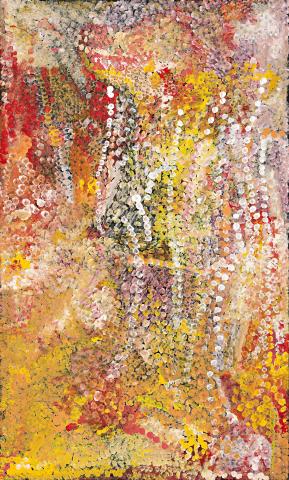UNTITLED (MERNE KAME), 1995
EMILY KAME KNGWARREYE
synthetic polymer paint on linen
151.5 x 91.0 cm
inscribed verso: artist’s name and Delmore Gallery cat. 95I015
Commissioned in September 1995 by Delmore Gallery, Alice Springs
Private collection, Melbourne
Emily Kame Kngwarreye: Alhalkere, Paintings from Utopia, Queensland Art Gallery, Brisbane, 20 February – 13 April 1998; Art Gallery of New South Wales, Sydney, 15 May – 19 July 1998; National Gallery of Victoria, Melbourne, 22 September – 22 November 1998; cat. 83 (label attached verso)
Neale M., Emily Kame Kngwarreye: Alhalkere, Paintings from Utopia, Macmillan Publishers, Melbourne, 1998, p. 28, pl. 13 (illus.)
Emily Kngwarreye started painting when she was nearly 80 years old. Before that she was one of the founding members of the Utopia Women’s batik group, a communal project to help desert women find a source of income from creating batik art. Despite the fact that Emily’s painting career only spanned seven years, she became one of the most outstanding and successful contemporary indigenous artists. Emily’s known for her use of vivid colours, lines and dots that mesmerize the viewer. The strong visual works are Emily’s vision and response to her birth land, Alhalkere, located at Utopia north-east of Alice Springs.
This impressive canvas, Untitled (Merne Kame), derives from the period that, by critics, is often referred to as her ‘spiritual’ phase. The mixture of warm colours in the background are overlaid with white fluid dots, varying in size and colour. As discussed by Hetti Perkins the ‘literal interpretations of these works describe an idiosyncratic and microcosmic view of the desert floor, grass seeds and flowers overlaying the organic subterranean networks that lie below the surface of the land. Analogies may be made to the dreaming tracks which traverse Australia, emanating from and linking the hundreds of Aboriginal communities around the country, like fluid rivers of spiritual power that sustain and nurture Aboriginal people and the land’.1
These complex singing canvases resemble in some way the American abstract expressionist paintings of Jackson Pollock. According to Pollock the canvas was ‘an arena in which to act...leaving the event in trails of paint.’2 Although Emily’s gestural mark-making seems to relate to Pollock’s action painting, the religious and cultural intentions completely separate the artists.
1. Perkins, H., Fluent, Sydney, 1997, pp. 14-16.
2. Neale, M., Emily Kame Kngwarreye: Alhalkere, Melbourne, 1998, p. 29.
SIMONE LANGEJAN
